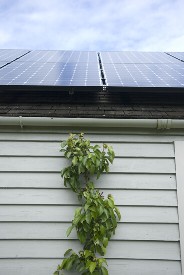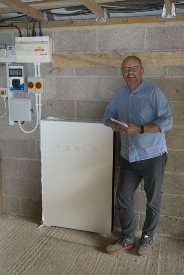









Robert Llewellyn’s Home of the Future
Comic actor, TV presenter and creator of Fully Charged, Robert Llewellyn, is a passionate proponent of new energy technologies. Fully Charged, started as a YouTube channel looking not just at electric vehicles, but also at the way electricity is generated from renewable sources. It’s now a global phenomenon, with live shows across the world. If you’re not following Fully Charged, we thoroughly recommend you do – it really is the best source of news about new energy technologies out there, and puts mainstream media to shame!
Why choose solar and storage?
Robert Llewellyn has had solar PV on the roof of his house in the Cotswolds for some years, but has increasingly felt he could do more. “I’ve had solar since 2011 and as soon as you have it, you want a battery. In theory, it makes so much sense and for once in life the practice proves the point”.
The design challenge
Robert is, of course, also passionate about his electric vehicles which also need charging at home. Our brief was to therefore boost his solar generation, utilise a greater percentage of the solar electricity on site, and use any excess to charge his cars.
The home of the future
We upgraded Robert’s existing solar PV system of 2.5kW conventional modules to 16 high efficiency Sunpower 327 modules, totalling 5.23kW. These high efficiency modules (over 21%) have doubled the generation from his roof space.
In order to use more electricity onsite, we installed one of the first Powerwall2 battery systems in the country. This Tesla solar battery unit is much larger than conventional battery units, holding an impressive 13.4kWh of energy. This greater battery capacity matches to the larger PV system – anything smaller would fill up too quickly.
The system works by using excess solar electricity to charge the Powerwall2 during the day. It discharges in the evening to loads in the house, but by midnight we don’t expect the battery to be empty. It’s at this point that the Powerwall2 discharges into Robert’s car batteries. The car batteries then fill any remainder with cheaper night-time tariff electricity.
This approach is perfect, as the battery is completely empty the next morning ready to capture the maximum possible solar energy throughout the day.
It is slightly unconventional to charge a battery (Powerwall2) and then discharge it into another battery (vehicles), and thermodynamically this might not seem sensible. It is, however, the best thing to do economically. Robert uses his free solar electricity first, then cheap night-time electricity, with any remaining (on poor days in winter) coming at standard day rates.
Early results were very promising. As Robert said:
“I’ve had the system running for 2 days and my mains electricity usage has reduced by 95%. Okay, it’s summer, it’s sunny, and over the year I’m sure it won’t manage that, but it’s obvious it will reduce our overall demand on the grid by a substantial amount and utilise far more of the power the panels produce.”
We think this is a perfect example of integrating solar generation, storage technologies and electric vehicle charging. It’s complex, from an engineering standpoint, as we have to balance PV capacity, battery storage capacity, loads in the house and electric vehicle loads, but we’ve found an optimal solution. The home of the future is increasingly going to incorporate all these technologies operating in combination.
One happy customer
“Joju Solar have been patient and supportive throughout the install of my new solar array and Powerwall 2 battery system. They needed to be patient due to my constant faltering, budget anxiety and ridiculous schedule. They fitted the battery in a day, wired it up, stayed longer than expected to make sure it was all working, left the place spotlessly tidy and did a very fine job.” – Robert Llewellyn
And there’s more!
We’ve since been back to Robert’s home for a further install. Watch this space for details.
Further reading
- We’ve developed a free guide to Tesla’s Powerwall2, so you can understand if it is the right option for you.
- You can see the installation process for Robert’s Powerwall2 in this technical blog
- The high efficiency Sunpower solar modules are essential to make this system work. Here’s our guide to the most efficient modules on the market
Date
June 15, 2017
Category
Batteries and smart grids, EV Charging, Featured, Residential, Solar, SunPower, Tesla, West Mids


